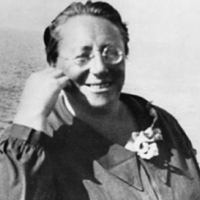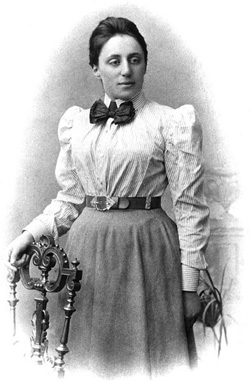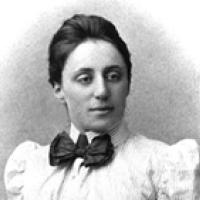
Emmy Noether: A creative mathematical genius
Brief summary
Emmy Noether (1882 - 1935) was one of the greatest mathematicians of her time, despite women being actively excluded from academia. She helped lay the foundations of abstract algebra and proved one of the key results in modern physics. As a Jewish mathematician she was forced to flee Germany in the 1930s, dying just a few years after moving to the USA.
"Fräulein Noether was the most significant creative mathematical genius thus far produced since the higher education of women began."
This is what Albert Einstein wrote in a 1935 letter to the New York Times, just after the mathematician Emmy Noether had died. And he wasn't the only one to praise her — many people think she was one of the greatest mathematicians of her time.
But what did Einstein mean by "creative mathematical genius"? Noether worked primarily in algebra, which is about writing symbols for mathematical objects, such as numbers. For example, instead of considering the two equations $$2x=10,$$ and $$3x=9$$ as being entirely different things, you can recognise that they belong to the family of equations that have the form $$ax=b$$ for some numbers $a$ and $b$. You can now work out a general solution: $$x=\frac{b}{a},$$ which works for every equation of that family. You simply have to fill in the appropriate values for $a$ and $b.$

Emmy Noether (around 1900-1910)
In a wider sense, algebra can describe the relationships between mathematical objects (numbers in our example) in their most general form. The relationships contain patterns and structures that a good mathematician can sense, just as a musician can feel the rhythms and structures in a piece of music. And just as a musician has to stick to certain rules when writing a new piece of music (otherwise it'll sound awful) so a mathematician is guided by the rules of logic when discovering new equations and relationships. In fact, Albert Einstein called pure mathematics the "poetry of logical ideas".
Noether published what is generally known as her most important paper, Ideal Theory in rings, in 1921 which was of fundamental importance in the development of modern algebra. But she is probably best known for her result in physics – Noether's Theorem – which forever tied modern physics to the very mathematical idea of symmetry.
The power of symmetry
As you might know, in physics there are certain quantities that are always conserved. An example is energy: energy can't be created out of nothing, and it can't just disappear. When you kick a football, the energy of your foot doesn't disappear after the kick, rather it's transferred to the ball. Another conserved quantity is momentum: that's the product of the mass and the velocity of an object. When you kick the ball, your foot might lose its momentum after the kick, but the momentum hasn't disappeared: it's been turned into the momentum of the ball. These conservation laws are regarded as truly fundamental in physics.
When Albert Einstein published his revolutionary general theory of relativity at the end of 1915 he had a problem. Eminent mathematicians, such as David Hilbert and Felix Klein, were concerned that conservation of energy didn't arise from general relativity the way it did in other theories describing the physical world.
The problem was a mathematical one and therefore required the help of a mathematician with expertise in the theory of invariants — things that do not change, as was claimed to be the case with energy. Emmy Noether was just such a mathematician and, on Hilbert's request, came to the rescue.
With great insight, Noether figured out how these conservation laws are reflected within the mathematical equations that describe the physics. Conservation of momentum, for example, is linked to the fact that the equations look the same no matter where you are in space — you use the same equations whether you are in London, New York or on the Moon. Conservation of energy is linked to the fact that the equations look the same no matter where you are in time — whether you apply them today, tomorrow, or in ten year's time.
When an object remains unchanged under some form of transformation mathematicians say that the object is symmetric. A picture of a butterfly has a mirror symmetry, for example, because you can reflect it in a line down its centre without changing its appearance. The equations we just talked about, which remain unchanged when you shift along in space or time, are also symmetric in that sense, since they don't change under the shifting transformation. Therefore, Noether's result links the conservation laws of physics with a concept that at might at first appear to have nothing to do with them: symmetry.
Although Noether was a mathematician, she was able to tie the concept of symmetry to these fundamental conservation laws in physics. This is because the mathematics of symmetry, and area known as group theory, can be formulated using algebra. And in this way Noether, a mathematician who specialised in algebra, could prove one of the most important results in modern physics.
Emmy Noether and the power of symmetry — Find out about how Emmy Noether forever tied physics together with symmetries.
Against the odds
Noether's work has had a huge impact both in modern mathematics and modern physics. Einstein, Hilbert and Klein were just some of the eminent mathematicians and scientists who understood the importance of her insight and achievements. But she had to fight every step of the way to be a mathematician.

Emmy Noether
Noether had to ask permission from professors to sit in on lectures when she entered university in 1900 – a time when women were still forbidden from receiving degrees. A change in the rules in 1904 meant she did graduate and went on to complete an excellent doctorate in 1907. But women were still not allowed to fill academic posts and she spent most of her life working without, or with only very little, pay and official recognition.
German mathematics, like much else, became highly politicised in the 1930s. Noether was one of the first six professors fired from Göttingen by the Nazis because she was both Jewish and politically liberal. Noether eventually found temporary positions at universities in the USA. Sadly, Noether died in exile of ovarian cancer. She was in her early fifties at the height of her creativity and powers.

Emmy Noether: Against the odds — Find out more about Noether's personal list and the challenges she faced as a female and a Jewish mathematician.
This article was produced as part of our collaboration with the Isaac Newton Institute for Mathematical Sciences (INI). The INI is an international research centre and our neighbour here on the University of Cambridge's maths campus. You can find all the content from the collaboration here.
